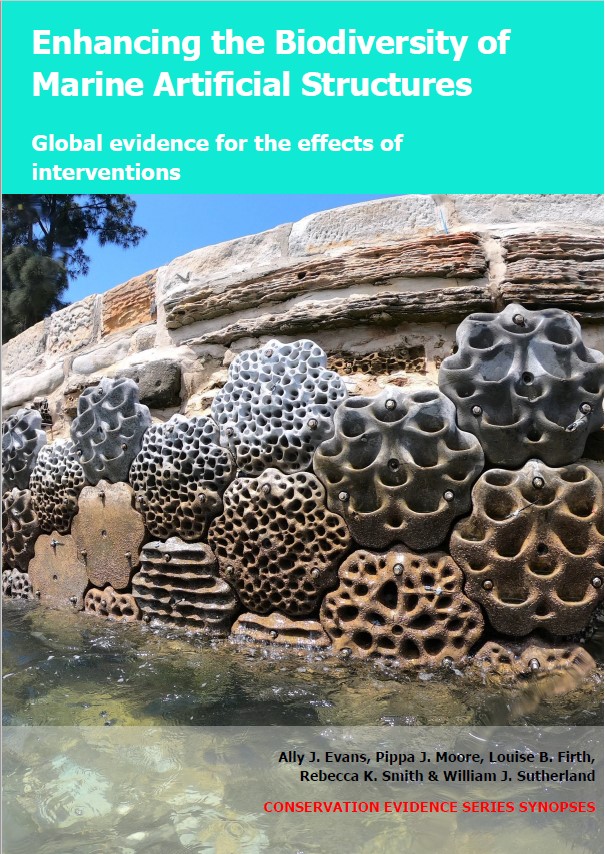Create groove habitats (1–50 mm) on subtidal artificial structures
-
Overall effectiveness category Awaiting assessment
-
Number of studies: 2
View assessment score
Hide assessment score
How is the evidence assessed?
-
Effectiveness
not assessed -
Certainty
not assessed -
Harms
not assessed
Study locations
Supporting evidence from individual studies
A controlled study in 1985–1989 on a subtidal breakwater block on open coastline in Toyama Bay, Japan (Watanuki & Yamomoto 1990) reported that groove habitats created on the block supported more kelp Ecklonia stolonifera but similar abundances of canopy algae Sargassum spp. compared with a block surface without grooves. Data were not statistically tested. After 42 months, there were 55 kelp individuals on the surface with large grooves (wet weight: 0.93 kg), 32 on the surface with small grooves (0.48 kg) and 20 on the surface without grooves (0.31 kg). Three canopy algae species had similar abundances and weights on the surface with large grooves (5–10 individuals, all 0.01 kg), small grooves (2–19 individuals, 0.01–0.04 kg) and without grooves (3–18 individuals, 0.05–0.17 kg). Groove habitats were created on a concrete breakwater block (2.3 × 2.3 × 0.8 m). There was one array of five large grooves (length: 644 mm; width: 46 mm; depth: 23 mm) and one of nine small grooves (length: 644 mm; width: 3 mm; depth not reported), evenly-spaced on 644 × 529 mm horizontal surfaces. One adjacent surface had no grooves. Small grooves were created by scraping using a nail (method for large grooves not reported). The block was placed on sandy seabed at 9 m depth in November 1985. Macroalgae on surfaces with and without grooves were counted and weighed (wet weight) after 42 months.
Study and other actions testedA replicated, controlled study in 2012–2014 on two subtidal breakwaters on open coastline in the Mediterranean Sea, Israel (Sella & Perkol-Finkel 2015) found that groove habitats created on breakwater blocks, along with holes, pits and environmentally-sensitive material, supported different macroalgae and invertebrate community composition with higher species diversity than standard-concrete blocks without added habitats, while macroalgae, invertebrate and fish abundances varied depending on the species group. After 24 months, the macroalgae and invertebrate species diversity was higher on blocks with added habitats than without (data reported as Shannon index) and the community composition differed (data reported as statistical model results). Thirty species (7 mobile invertebrates, 14 non-mobile invertebrates, 9 fishes) recorded on and around blocks with added habitats were absent from blocks without. Species abundances varied on blocks with and without added habitats depending on the species group (see paper for results). It is not clear whether these effects were the direct result of creating grooves, holes, pits, or using environmentally-sensitive material. Groove habitats were created on breakwater blocks (1 × 1 × 1 m) using a formliner. Each block had multiple irregular grooves (length: 100–600 mm; width: 5–15 mm; depth: 10 mm; T. Hadary pers. comms.) amongst multiple holes and pits (number/spacing not reported). Five blocks of each of three patented ECOncreteTM materials (lower pH and different cement/additives to standard-concrete) were placed at 5–7 m depth on a concrete-block breakwater during construction in July 2012. Five standard-concrete blocks (1.7 × 1.7 × 1.7 m) without added habitats were placed on a similar breakwater 80 m away. Macroalgae and invertebrates on blocks, and fishes on and around blocks, were counted over 24 months.
Study and other actions tested
Where has this evidence come from?
List of journals searched by synopsis
All the journals searched for all synopses
This Action forms part of the Action Synopsis:
Biodiversity of Marine Artificial Structures
Biodiversity of Marine Artificial Structures - Published 2021
Enhancing biodiversity of marine artificial structures synopsis





)_2023.JPG)














